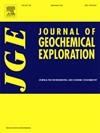南岭白石张钼(-W)矿床矿床成因:来自黑钨矿年代学和化学成分的制约
IF 3.4
2区 地球科学
Q1 GEOCHEMISTRY & GEOPHYSICS
引用次数: 0
摘要
华南地块是中国最重要的钼矿成矿区之一,含斑岩、夕卡岩、石英脉等钼矿床40多处。本文采用原位激光烧蚀-电感耦合等离子体质谱法(LA-ICP-MS)分析了南岭成矿带白石张石英脉型钼(-W)矿床的U-Pb同位素和微量元素,研究了矿床地质和黑钨矿化学特征。BSZ矿床热液史可划分为石英-黑钨矿、硫化物和方解石三个阶段,前两个阶段为主要成矿阶段,黑钨矿为这两个阶段提供了岩石学证据。Wol(I)产生的U-Pb年龄为154.0±1.2 Ma (1σ;n = 20;MSWD = 0.86)和Wol (II) 150.8±0.5岁硕士(Wol (II-1); 1σ;n = 19;MSWD = 1.0)和146.1±2.3 Ma (Wol(II-2);1σ;n = 12;MSWD = 2.6),涵盖了石英-黑钨矿阶段向硫化物阶段的过渡。Wol(II-1)矿化可能与黑云母钾长石花岗岩侵位(150.3±1.1 Ma)有关,大规模钼矿化可能与BSZ深部隐伏花岗岩有关。结果表明,黑钨矿的组成受结晶化学效应和矿化流体组成的双重制约,并且控制Wol(I)和Wol(II)化学组成的取代机制不同。Wol(II)呈现出从核心到边缘的组成变化和Eu异常,可能反映了来自隐伏花岗岩的富含锡和钼的外部还原流体的影响,导致Mo矿化。BSZ矿床的成矿模式可以更好地解释两个主要成矿阶段的不同形成过程。本文章由计算机程序翻译,如有差异,请以英文原文为准。

Ore genesis of the Baishizhang Mo(-W) deposit in the Nanling Range, South China: Constraints from wolframite geochronology and chemical composition
The South China Block (SCB), as one of the most important molybdenum metallogenic provinces in China, contains >40 Mo deposits including porphyry, skarn, and quartz-vein systems. In this work, we examine the ore geology and wolframite chemistry of the Baishizhang (BSZ) quartz vein-type Mo(-W) deposit in the Nanling Metallogenic Belt, using in-situ laser ablation-inductively coupled plasma-mass spectrometric (LA-ICP-MS) analysis of U-Pb isotopes and trace elements. The hydrothermal history of the BSZ deposit can be divided into three stages (i.e., quartz-wolframite, sulfide, and calcite), the first two of which are the two main mineralization stages and wolframite shows petrological evidence for these two stages. Wol(I) yielded a U-Pb age of 154.0 ± 1.2 Ma (1σ; n = 20; MSWD = 0.86) and Wol(II) ages of 150.8 ± 0.5 Ma (Wol(II-1);1σ; n = 19; MSWD = 1.0) and 146.1 ± 2.3 Ma (Wol(II-2); 1σ; n = 12; MSWD = 2.6), bracketing the transition from the quartz-wolframite stage to the sulfide stage. The Wol(II-1) mineralization may be genetically related to emplacement of biotite K-feldspar granite (150.3 ± 1.1 Ma), and the large-scale Mo mineralization may be related to deep concealed granites at BSZ. Our results show that the composition of wolframite was constrained by both crystallochemical effects and the composition of the mineralizing fluid, and that the substitution mechanisms controlling the chemical compositions of Wol(I) and Wol(II) were different. Wol(II) exhibits changes in composition and Eu anomaly from the core to the rim, likely reflecting the influence of an external reducing fluid enriched in Sn and Mo from concealed granites that caused Mo mineralization. A metallogenic model of the BSZ deposit can be applied to better interpret the various formation processes of the two main mineralization stages.
求助全文
通过发布文献求助,成功后即可免费获取论文全文。
去求助
来源期刊

Journal of Geochemical Exploration
地学-地球化学与地球物理
CiteScore
7.40
自引率
7.70%
发文量
148
审稿时长
8.1 months
期刊介绍:
Journal of Geochemical Exploration is mostly dedicated to publication of original studies in exploration and environmental geochemistry and related topics.
Contributions considered of prevalent interest for the journal include researches based on the application of innovative methods to:
define the genesis and the evolution of mineral deposits including transfer of elements in large-scale mineralized areas.
analyze complex systems at the boundaries between bio-geochemistry, metal transport and mineral accumulation.
evaluate effects of historical mining activities on the surface environment.
trace pollutant sources and define their fate and transport models in the near-surface and surface environments involving solid, fluid and aerial matrices.
assess and quantify natural and technogenic radioactivity in the environment.
determine geochemical anomalies and set baseline reference values using compositional data analysis, multivariate statistics and geo-spatial analysis.
assess the impacts of anthropogenic contamination on ecosystems and human health at local and regional scale to prioritize and classify risks through deterministic and stochastic approaches.
Papers dedicated to the presentation of newly developed methods in analytical geochemistry to be applied in the field or in laboratory are also within the topics of interest for the journal.
 求助内容:
求助内容: 应助结果提醒方式:
应助结果提醒方式:


